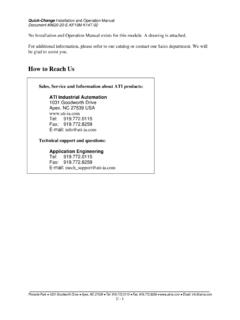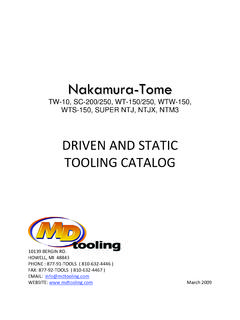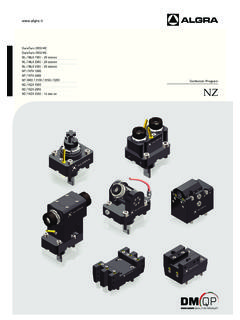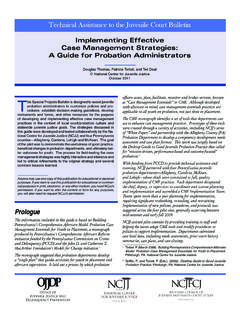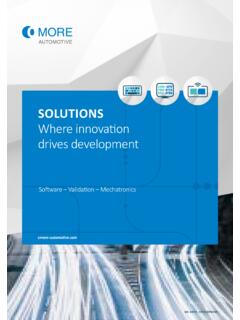Transcription of Robotic/Automatic Tool Changer - ati-ia.com
1 Robotic/AutomaticToolChangerQuick-Change StandardandHeavyAutomationSeries2 VISIT FOR CURRENT PRODUCT SPECIFICATIONS, 2-D DRAWINGS, AND 3-D CAD MODELSP roduct DescriptionThe Quick-Change provides flexibility to robotapplicationsby allowing the robot to change end-effectors ( , grippers, vacuum cup tooling, pneumaticand electric motors, weld guns, etc.) automatically. TheQuick-Change consists of a Master plate and a Tool Master plate, installed on the robot arm, locks tothe Tool plate with a pneumatically-driven lockingmechanism. This locking mechanism uses a patented,multi-tapered cam with ball locking technology and apatented fail-safe mechanism. The Master allows forthe passage of pneumatic and electrical connections tothe Tool Tool plate is attached to each end-effector. The Toolplate interfaces with the Master plate s pneumatic andelectrical connections and passes them on to the Tool Changer AdvantagesLines changedin seconds instead of safety increasedby changing tools changed in secondsfor maintenance and flexibilityof your robots by adding the abilityto use more than one end-effector in an and large multi-tool end-effectors replacedwith individual tools that are automatically Tool Changer AdvantagesSuperior Fail-safe Locking:The locking mechanismhas a built-in patented fail-safe feature that keeps theTool plate secured to the Master plate in the event ofpneumatic pressure loss.
2 This fail-safe featureeliminates the need for a Rigidity:The Quick-Change has a high momentcapacity due to the locking piston s large diameter andsecond taper. The Quick-Change does not rock duringhigh-inertia moves, preventing locking failure orrepeatability Repeatability:The piston acts as a largedowel pin, aligning the Master and Tool with remarkablerepeatability. Repeatability specifications are based onmillion-cycle LockingTMTe chnology:The Quick-Changecan lock successfully with a gap between the Masterand Tool Warranty:Our warranty is based on years ofobservation and analysis by our customers in the fieldand extensive laboratory Interface:Plate design allows for easy FOR CURRENT PRODUCT SPECIFICATIONS, 2-D DRAWINGS, AND 3-D CAD MODELS 3 It is highly recommended that ATI s Tool Changer beconsidered when looking at any kind of automatic tooldisconnect or application using this type of design. Joe MitoryASME Project ManagerTable of ContentsQuick-Change Locking Mechanism.
3 5 Quick-View Specification Table ..6 Model Selection ..7 Module Selection ..8QC-5 ..10QC-11 ..12QC-20 ..14QC-21 ..16 Tool Stands for QC-5 to QC-21 ..18QC-40 ..20QC-41 ..22QC-60 ..24QC-71 ..26QC-110 ..28QC-150 ..30 Tool Stands for QC-40 to QC-150 ..32 Sensor Interface Plate System ..34QC-300 ..36 Standard Series Modules and Options ..38 Quick-Change Family(left to right from back row; Master plate is standing, Tool plate is lying flat directly in front of each Master plate or to theright); QC-150; QC-210; QC-110; Middle row: QC-71; QC-60; QC-41; Front row: QC-40; QC-5; QC-11; Changers for Heavy Automation ..42QC-210 ..44QC-310 ..46QC-510 ..48 How To Order QC-210 to QC-510 ..50 Tool Stands for QC-210 to QC-510 ..51QC-1210 ..54 Heavy Automation Series Modules and Options ..56 Tool Changer Accessories ..62 Utility Couplers ..63 Special Application Tool Changers ..664 VISIT FOR CURRENT PRODUCT SPECIFICATIONS, 2-D DRAWINGS, AND 3-D CAD MODELSTOOL CHANGERSQ uick-Change Tool ChangersATI provides two distinct series of its line of Quick-Change Tool Changers: Standard and HeavyAutomation.
4 Both feature similar functioning lockingmechanisms, but they have different body designs andpayload abilities to best suit specific applications. Standard Series Tool ChangersFrom the lightest duty to the heaviest duty payloadrange, the Quick-Change Standard Series Tool Changerstypically feature round bodies with an array ofintegrated pneumatic style results in a compact, economical toolingarrangement where a majority of the applications savemoney and space by utilizing the built-in , even for applications where additionalelectrical signals or other utilities need to be coupled,the Standard Series Tool Changers feature one or twoadditional utility module mounting flats. Additional options for Standard Series Tool Changersinclude a Sensor Interface Plate (combined adapterplate and sensor pack for Lock and Unlock status), basicInterface Plates, and modular, highly-customizable ToolStorage Stand Automation Tool ChangersThe Heavy Automation Series Tool Changers featuresimple, compact, square Tool Changer bodies designedfor heavy-duty applications ( , welding).
5 Instead ofintegrated pneumatic ports, the area of the body ismaximized for fitting the largest, strongest lockingmechanism possible. Each Tool Changer features built inLock/Unlock/Ready-to-Lock sensors, as well as heavy-duty alignment pins. The square shape allows formounting four or more utility modules to passpneumatics, fluid, electrical, fiber optic, weld current, andmore. This unique series of heavy-duty Tool Changers isalso compatible with an economical Tool Stand familythat includes compliant drop-off points, Tool Shields, anda highly-customizable array of FOR CURRENT PRODUCT SPECIFICATIONS, 2-D DRAWINGS, AND 3-D CAD MODELS 5 Interface platePistonLock air pressure pushes thepiston down, driving the balls outand under the bearing race ring,pulling up the Tool Tool plate will not releasefrom the Master plate unlessunlock air pressure is 1:Tool Changer in unlockedpositionFigure 2b:Section view of Tool Changerin Ready-to-Lock position(interface plate not shown)Our patented locking mechanism andunique fail-safe feature have been inindustrial use for more than fifteenyears without failure.
6 Our No-Touch Locking technologyallows plate separation when 3b:Section view of Tool Changerin locked positionFigure 4b:Section view of Tool Changerin fail-safe position*Video available on plateElectrical module (Master-side)Male couplingTool plateElectrical module (Tool-side)Bearing raceNo-Touch LockingCamHardened steel ball is on the first taper of the taper allows Master andTool to be separate 2a:Close--up of locking ballposition with Tool Changer inReady-to-Lock positionHardened steel ball is on thesecond taper of the cam forhigh repeatability and 3a:Close-up of locking ballin locked positionFail-safe conical surface(reverse taper)First taperHardened steel ball is on fail-safe conical surface.(reverse taper) In the event lock air pressure is removed, the balls aretrapped by the fail-safe prevents thecam and piston from movingdue to gravity, vibration oracceleration. Figure 4a:Close-up of locking ballwhile in fail-safe positionQUICK-CHANGE LOCKING MECHANISMOur patented fail-safe locking mechanism features a unique multi-tapered cam for superior reliability, repeatability, strength, and taper(pick-up)2nd taper(locked)3rd taper(fail-safe)Bearing race6 VISIT FOR CURRENT PRODUCT SPECIFICATIONS, 2-D DRAWINGS, AND 3-D CAD MODELS*Additional pneumatic pass-through ports are available for these models.
7 **All models can handle a dynamic moment 3 times higher than thestatic moment capacity. Moment tests show failure point at 10 12 times X and Y static moment specifications. Higher payloads possible withlow moment. Metric pass-through ports available on most models, contact ATI for more Payload Limit18 lb35 lb55 lb55 lb110 lb110 lb( kg)(16 kg)(25 kg)(25 kg)(50 kg)(50 kg)Locking Force @ 80 psi ( bar)160 lb240 lb520 lb520 lb1000 lb1000 lb(690 N)(1100 N)(2300 N)(2300 N)(4500 N)(4500 N) static Moment Capacity (X and Y)**110 lbf-in220 lbf-in500 lbf-in500 lbf-in1400 lbf-in1400 lbf-in(12 Nm)(25 Nm)(56 Nm)(56 Nm)(160 Nm)(160 Nm) static Moment Capacity (Z)150 lbf-in300 lbf-in690 lbf-in690 lbf-in1900 lbf-in1900 lbf-in(17 Nm)(34 Nm)(78 Nm)(78 Nm)(220 Nm)(220 Nm)Pneumatic pass-through(6) M5(6) M5(12) M5*(8)(8)*(6) 3/8 NPT(Quantity) sizeor #10-32or #10-32or #10-321/8 NPT1/8 NPT(4) 1/8 NPTP neumatic Lock and Unlock port sizeM5M5M5M51/8 NPT1/8 NPTor #10-32or #10-32or #10-32or #10-32 DescriptionQC-210QC-310QC-510QC-1210 Suggested Payload Limit600 lb1100 lb1500 lb2980 lb(270 kg)(510 kg)(700 kg)(1350 kg)Locking Force @ 80 psi ( bar)7000 lb8600 lb14,000 lb21,000 lb(31,000 N)(38,000 N)
8 (62,000 N)(93,450 N) static Moment Capacity (X and Y)**24,000 lbf-in29,000 lbf-in43,000 lbf-in48,000 lbf-in (2700 Nm)(3300 Nm)(4900 Nm)(5400 Nm) static Moment Capacity (Z)20,000 lbf-in28,000 lbf-in31,000 lbf-in48,000 lbf-in(2300 Nm)(3200 Nm)(3500 Nm)(5400 Nm)QUICK-VIEW SPECIFICATION TABLED escriptionQC-60QC-71QC-110QC-150QC-300 Suggested Payload Limit160 lb180 lb330 lb440 lb1000 lb(75 kg)(79 kg)(150 kg)(200 kg)(450 kg)Locking Force @ 80 psi ( bar)1700 lb1800 lb2700 lb3600 lb7900 lb(7400 N)(8100 N)(12,000 N)(16,000 N)(35,000 N) static Moment Capacity (X and Y)**1700 lbf-in3500 lbf-in6900 lbf-in12,000 lbf-in29,000 lbf-in(200 Nm)(400 Nm)(780 Nm)(1400 Nm)(3300 Nm) static Moment Capacity (Z)2600 lbf-in3500 lbf-in6900 lbf-in10,000 lbf-in25,000 lbf-in(290 Nm)(400 Nm)(780 Nm)(1100 Nm)(2800 Nm)Pneumatic pass-through(8)*(8)*(8)*(10)*(10)*(Quant ity) size1/8 NPT1/4 NPT3/8 NPT3/8 NPT3/8 BSPP (G)Pneumatic Lock and Unlock port size1/8 NPT1/8 NPT1/8 NPT1/8 NPT1/4 BSPP (G)Pneumatic pass-through ports are available for these models.
9 **All models can handle a dynamicmoment 3 times higher than the static moment capacity. Higher payloads possible with low FOR CURRENT PRODUCT SPECIFICATIONS, 2-D DRAWINGS, AND 3-D CAD MODELS 7 MODEL SELECTIONHow to Select a Robotic Tool Changer1. Sizing - Fast method:If the expected momentexerted on the Tool Changer is low or moderate, selecta Quick-Change model with a payload rating similar tothat of your robot. If the expected moment is high, or ifyou prefer to use a QC model better suited to theapplication, see the next section exact method:Moment capacity is a criticalfactor in selecting the proper Quick-Change model. Usethe following to approximate the worst-case moment: Find the approximate center-of-gravity (CG) of theheaviest end-effector to be used. Calculate the distance (D) from the CG to thebottom of the Tool plate (example below). Calculate the weight (W) of the heaviest end-effector. Multiply W by D to get an approximate staticmoment (M) (or a moment based on one G ofacceleration).
10 Select a Quick-Change with a moment capacityequal to or greater than may produce moments two-to-three times higherthan M due to their potentially high acceleration. TheQuick-Change models are designed to handle dynamicmoments three times higher than their static Pneumatic and Electrical:Determine the number andsize of pneumatic ports and electrical contacts Quick-Change models have a greater number ofpneumatic ports and electrical Temperature and Chemicals:The Quick-Changeuses nitrile bushings to pass pneumatics to the Toolplate, and Buna-N O-rings to seal the pneumatic only is this rubber material resistant tomost chemicals, it is able to withstand temperaturesranging from -20 F to 150 F. Please contact your ATIA ccount Manager for information regardingtemperatures or chemicals for particular Precision Applications:Be sure to refer to thespecifications when dealing with applications that requirehigh :A Tool Changer affects robot momentcapacity, payload, size, and repeatability.

